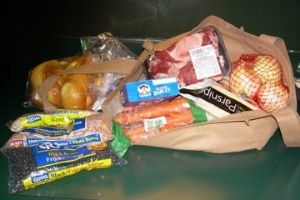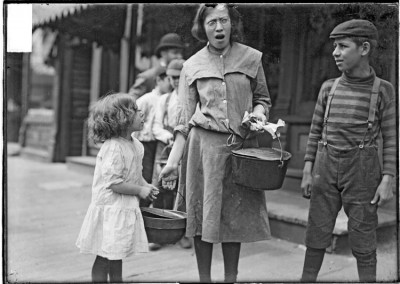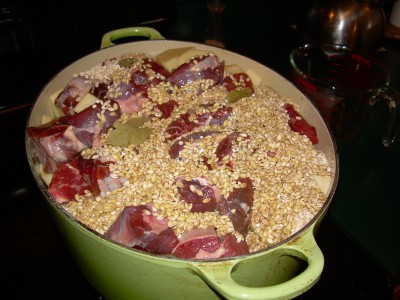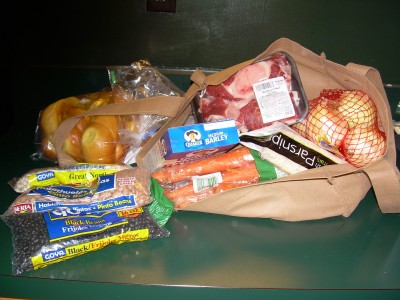Thanking Gil Marks

A blog post by Curator Karen Falk. To read more posts from Karen click HERE.
I never met him, but I and the JMM owe a great debt to the late rabbi and historian of Jewish food Gil Marks, who died on December 5. Marks’ magnum opus, The Encyclopedia of Jewish Food was published in 2010 and became an enormously important reference for our 2011 exhibition, Chosen Food: Cuisine, Culture, and American Jewish Identity. It’s a remarkable work with entries for dishes from Jewish communities around the world, and for the Jewish meanings of foods one would never think of as “Jewish.” His entry on “Challah,” for example, explains the meaning and origins of the name of our delicious Sabbath bread, and describes the sort of loaf it actually referred to in the time of the Jewish Kingdom. He also has an entry on “Salt.” The book also contains recipes and detailed instructions for several of his entries. I have given it as a gift to several of my foodie friends, and I consult my own copy frequently. I highly recommend it as an irreplaceable resource and a fun read.
Recently published remembrances of Rabbi Marks note that even greater than his knowledge of Jewish food and its importance to Jewish culture and identity was his enthusiasm and generosity in sharing his knowledge and work with all who asked. The JMM experienced this generosity first-hand when in 2012 he allowed us to post the recipes for cholent and cholent kugel on our Chosen Food blog. With gratitude for his generosity and sorrow at his loss, here is an excerpt from that post.
I decided to try a cholent made “the right way,” turning for instruction to Gil Marks’ Encyclopedia of Jewish Food http://www.gilmarks.com/. Here I found not only the recipe, but the fascinating history of this very Jewish food.

Cholent (also called schalet), based on the slow cooked stews (hamin, from the Hebrew word meaning “hot”) of the Mizrachi and Sephardi Jews, reached the Ashkenazim of Eastern Europe in the 12th or 13th century, via Spain and France. The word cholent may be derived from the Old French word for warm (chald/chalt) or it may come more directly from the Spanish escallento, also meaning warm. It became the custom for the homemakers of Europe to bring their pots of stew, lids sealed with flour paste to ensure against non-kosher taint, to the local bakery where the coals were banked to remain hot during Shabbat—a custom followed in Europe until the Shoah, and also brought by immigrants to the United States.
Cholent ingredients I arranged the ingredients in the pot, following the order specified in Marks’ recipe. I had a little trouble with “water to cover,” since my pot was very full. (In fact, it boiled over during the cooking, leaving me with a major post-Shabbat cleaning project.) Don’t skip the hour long simmer Marks recommends. The cholent must go hot into the oven.

Two teaspoons of salt seemed like a lot to me, but it turns out to be just right. And don’t make the recipe at all if you don’t like the flavor of bay leaves. This ingredient is absolutely essential!
I topped the cholent with Marks’ cholent kugel, rolled into a long log that extended down the center of the cholent, from one end of the pot to the other. When I lifted the heavy lid the next day, I found the loaf flattened into an oval, but it was a beautiful brick red-brown from the paprika. It was surprisingly delicious, if somewhat solid.
How was the cholent? The beans and barley were not only cooked through, they almost lost definition. The meat was melt-in-your-mouth soft, and the seasonings were just on the edge of overcooked. I would have liked a little more gravy; don’t lose yours over the side of the pot!
Recipes (courtesy of the Encyclopedia of Jewish Food, by Gil Marks)
Ashkenazic Sabbath Stew (Cholent)
6 to 8 servings
1 ½ pounds beef or veal marrow bones
About 2 cups any combination mixed dried navy, lima, pink, pinto, and kidney beans
3 medium yellow onions, sliced
2 to 3 cloves garlic, whole or minced
6 medium potatoes, peeled and quartered
3 pounds beef flanken, brisket, or chuck roast
¾ to 1 cup barley
2 to 3 bay leaves
About 2 teaspoons table salt or 4 teaspoons kosher salt
About 1 teaspoon ground black pepper
About 2 quarts water
1. In the order given, place the bones, beans, onions, garlic, potatoes, beef, barley, bay leaves, salt and pepper in a large, heavy pot. Add enough water to cover.
2. Bring to a boil, cover, reduce the heat to medium-low, and simmer, skimming the froth from the surface, until the beans are nearly soft, about 1 hour.
3. Add more water if necessary. Tightly cover, place on a blech (a thin sheet of metal placed over the range top and knobs) over low heat, or in a 225° F oven, and cook overnight. Serve warm.
Cholent Kugel
4 to 6 servings
5 thick slices challah or 2 large rolls, torn into small pieces
1 ½ cups (7.5 ounces) all-purpose flour
¼ cup vegetable oil or schmaltz
1 large egg, lightly beaten
1 to 3 teaspoons paprika
About 1 teaspoon table salt or 2 teaspoons kosher salt
½ teaspoon ground white or black pepper
In a medium bowl, soak the challah in water until soft but not mushy, about 2 minutes. Drain and squeeze out the excess moisture. Place in a medium bowl and mash until smooth. Add the flour, oil, egg, paprika, salt, and pepper, adding more flour if too loose; the mixture should be able to hold its shape. Form into a log and place it on top of hot cholent [before placing the cholent into the oven].

